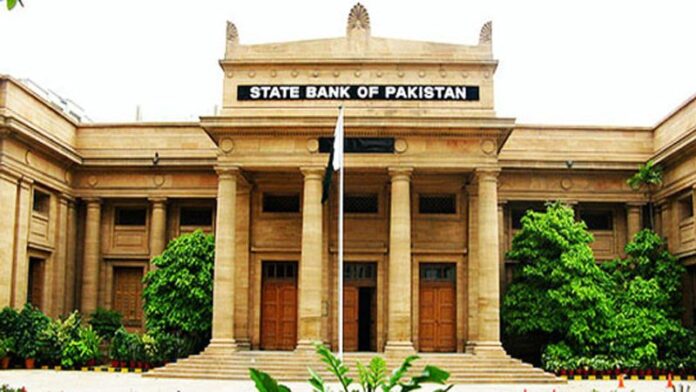The State Bank of Pakistan announced a 150bps policy rate hike following the Monetary Policy Committee meeting earlier today.
The SBP states, “This action, together with much needed fiscal consolidation, should help moderate demand to a more sustainable pace while keeping inflation expectations anchored and containing risks to external stability.”
The MPC’s baseline outlook assumes continued engagement with the IMF, as well as reversal of fuel and electricity subsidies together with normalization of the petroleum development levy (PDL) and GST taxes on fuel during FY23.
With monetary tightening happening amidst an expansionary fiscal policy, the policy rate hike will now make government borrowing more expensive. This may push the government towards fiscal prudence.
SBP also revised up EFS and LTFF rates to 7.5% and 7% respectively to lower demand pull inflation and control the current account deficit.
“SBP skipped the inflation target for FY23 along with the forward guidance in the monetary policy statement,” says Tahir Abbas, Head of Research at Arif Habib Limited.
This is the first MPC meeting led by Dr. Murtaza Syed, acting governor of the SBP.
Divergence in monetary and fiscal policy
The MPS pointed towards the pressures added by an expansionary fiscal policy. The SBP said that the fiscal stance in FY22 is now expected to be expansionary instead of budgeted consolidation.
“The central bank’s statement conveys, in so many words, that the real problem lies on the fiscal side. Without the economic managers in power agreeing to cut spending, the bank will always keep playing catchup,” says Uzair Younus, Director of the Pakistan Initiative at the Atlantic Council. “However, the hike once again indicates that the bank is behind the curve and is hesitant to impose severe costs on the government for abandoning fiscal prudence,” adds Younus
“External pressures remain elevated and the inflation outlook has deteriorated due to both home-grown and international factors. Domestically, an expansionary fiscal stance this year, exacerbated by the recent energy subsidy package, has fueled demand and lingering policy uncertainty has compounded pressures on the exchange rate,” read the statement.
The SBP further adds that the primary deficit during the first three quarters of the year compares unfavorably with the primary surplus of 0.8 percent of GDP during the same period last year. “This slippage was driven by a sharp rise in non-interest expenditures, led by higher subsidies, grants and provincial development expenditures.”
As per the SBP, the resulting demand pressures have coincided with the sharp rise in costs from the surge in global commodity prices, exacerbating inflationary pressures and the import bill.
The SBP calls for “timely action” to “restore fiscal prudence, while providing adequate and targeted social protection to the most vulnerable.”
Highlighting the importance of fiscal prudence, the SBP mentions, “Such prudence enabled Pakistan’s public debt to decline from 75 percent of GDP in FY19 to 71 percent in 2021 despite the Covid shock, in sharp contrast to the average increase of around 10 percent of GDP across emerging markets over the same period.”
On the monetary front, private sector credit remained robust during April. As per the SBP this signifies strong economic activity but also depicts higher input prices pushing up working capital requirements of firms.
Since the last MPC meeting, secondary market yields, benchmark rates and cut-off rates in the government’s auctions have risen, particularly at the short end. majority participation was witnessed in 3M with investors preferring to invest in the shortest tenor in anticipation of any further rate hike.
The SBP, however, also commented on how it would fasten its pace at tightening if needed. “The MPC noted that the market rates should be aligned with the policy rate and in case of any misalignment after today’s policy decision, SBP would take appropriate action”.
As per Dr Sajid Amin, Deputy Executive Director at SDPI, “The market was expecting a rate hike as the SBP was behind the yield curve. MPS seems to suggest that SBP is running for getting back on the curve. I think SBP should not respond to the market every time as it may get into a no-ending race.”
Inflation and the chance of real interest rates
Headline inflation rose from 12.7 percent over last year in March to 13.4 percent in April. The SBP says inflation was driven by perishable food items and core inflation. The rise in core inflation as per the statement reflects strong domestic demand and second-round effects of supply shocks.
“After contracting by 0.9 percent in FY20 in the wake of Covid, the economy has rebounded much more strongly than anticipated, growing by 5.7 percent last year and accelerating to 5.97 percent this year, as per provisional estimates. At 13.4 percent (y/y), headline inflation unexpectedly rose to a two-year high in April and has now been in double digits for six consecutive months.”
The SBP sees measures of long term inflation expectations to be on the upwards side. “As electricity and fuel subsidies are reversed, inflation is likely to rise temporarily and may remain elevated through FY23 before declining sharply during FY24. This baseline outlook is subject to risks from the path of global commodity prices and the domestic fiscal policy stance.”
The SBP notes that despite “encouraging moderation in the current account deficit during April”, the Rupee depreciated further. As per the MPC, this depreciation was due to domestic uncertainty as well as recent strengthening of the US dollar in international markets following tightening by the Federal Reserve.
External Front
“Based on PBS data, the trade deficit shrank by 24 percent relative to its peak last November. These developments are in line with SBP’s projected current account deficit of around 4 percent of GDP this year,” read the statement.
The SBP expects the current account deficit to narrow to around 3 percent of GDP as import growth continues to slow with moderating demand along with the recent measures taken by the government to curtail non-essential imports. The SBP sees exports and remittances to remain resilient.
The reserves, however, remain a concern at the moment. The SBP notes, “This narrowing of the current account deficit together with continued IMF support will ensure that Pakistan’s external financing needs during FY23 are more than fully met, with an almost equal share coming from rollovers by bilateral official creditors, new lending from multilateral creditors, and a combination of bond issuances, FDI and portfolio inflows.”
The statement further reads, “As a result, excessive pressure on the Rupee should attenuate and SBP’s FX reserves should resume their previous upward trajectory during the course of the next fiscal year.”

























The SBP states, “This action, together with much needed fiscal consolidation, should help moderate demand to a more sustainable pace while keeping inflation expectations anchored and containing risks to external stability.”